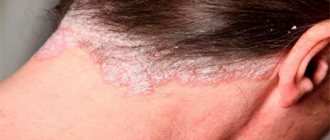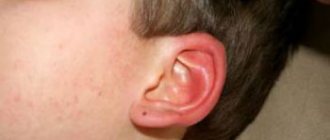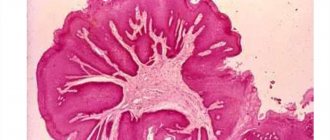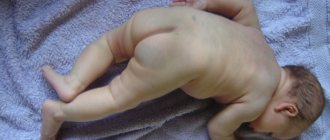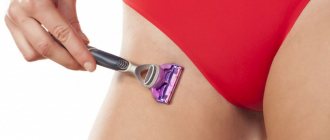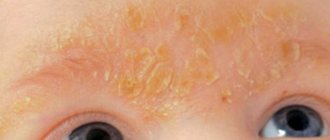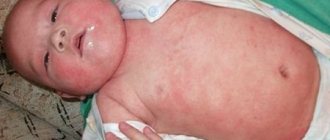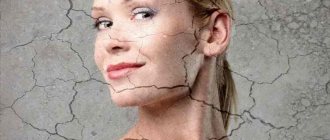A child may experience dry scalp, especially in the first year of life, which is usually caused by childhood seborrheic dermatitis. Research shows that more than 50% of babies under 1 year of age have dry scalp, which appears a few weeks after birth and most often occurs around 3 months of age.
Only 7% of infants remain symptomatic after the first year of life. When this condition occurs in adults or older children, it is often called dandruff.
. Usually, a baby with dry scalp does not need treatment, and the issue resolves itself.
What to do if your skin is peeling
If the baby has strong crusts and they need to be removed, you need to do this very carefully.
If a newborn has flaking on the head, for a better result, you can apply a moisturizer, put a cap or towel on the head and leave for 20 minutes. Then the baby needs to be bathed and the softened crusts will disappear. The procedure can be performed daily. The use of sharp combs is strictly prohibited; they can injure already delicate and inflamed skin. Dry skin in babies can be removed with the help of cosmetic baby creams. You can use them morning and evening to prevent unpleasant flaking from increasing. Such care should not be carried out very often, so as not to aggravate the skin condition and increase dryness. Remember: if you bathe your child often, the poor functioning of the sebaceous glands will become even worse.
Be careful with chemistry
The advice on using various creams in the previous paragraphs could alert parents who understand what even a relatively safe “children’s” cosmetic product consists of. You need to be aware that there is a possibility that the body will not accept the “chemistry” of a particular product, regardless of whether it is a product for children or an ordinary “adult” tube.
How to determine?
- The child’s skin peels on the legs, arms, head and body when it comes to cosmetic products.
- It appears in places of contact with clothing and diapers, if we are talking about powder.
- This peeling can occur at any age.
What to do?
- Do not use products that are known to dry the skin (soap, shower gels).
- Try changing the remedy if the current one is suspicious.
- Search until you find a product that your baby’s skin will accept without any whims.
Do not be afraid of household chemicals and cosmetics in general and do not develop a phobia: the child’s body must get used to them, since in the future it is unlikely that he will live on a remote farm without washing powder and shower gel.
Why does my baby's skin peel?
When the baby is in the womb, the whole body is covered with vernix, which is a viscous grayish secretion. This substance protects the baby's delicate skin and facilitates passage through the birth canal during childbirth. Immediately after birth, the baby’s body is completely covered with this “protective layer of mucus.”
Previously, the midwife would gently wipe the baby, carefully removing the secretion, but today many pediatricians and neonatologists believe that the lubricant should not be intentionally removed - it ensures the baby’s skin adapts to the new environment (from “water” to “air”) and prevents the skin from drying out. Complete absorption of vernix lubrication into the skin occurs during the first two to three days of life.
Then, on the third day of life, its remains in the folds or behind the ears should be removed with ordinary vegetable oil, boiled in a water bath and slightly warmed before use.
But even if everything is done correctly and the original lubricant is not removed, but is absorbed into the skin, peeling and even peeling of the surface epithelium of the skin (the skin “peeles”) or drying out is often observed. Therefore, you need to carefully monitor the reaction of the skin of a newborn or infant after bathing.
The causes of peeling skin in a newborn can be:
The baby spent a long period of time in the comfortable microclimate of his mother’s tummy and suddenly found himself in a new world, to the conditions of which all organs and systems of the body, including the skin, must adapt. She comes into contact with air, various types of clothing, diapers, and gradually everything returns to normal.
Of great importance is the level of air humidity in the children's room, which normally ranges from 55 to 70%. Only under these conditions will the child’s skin not feel discomfort, and the baby will not feel thirsty and suffer from dry skin and mucous membranes. To check the level of moisture in the air, a special device is used - a hydrometer, which is located near the baby’s permanent location, most often a crib.
At low humidity levels, use various air humidifiers and place containers with water in the room, but with mandatory humidity control. Humidifiers are used not only in summer, but also in winter, due to drying of the air during the heating season. Low humidity levels in the apartment have a negative impact on the health of the baby:
- persistent peeling of the skin in a newborn is observed, sometimes significant detachment of the epidermis can be observed, and this significantly increases the risk of the addition of pathogenic microflora, especially with mechanical damage to the skin (scratches, diaper rash, dermatitis);
- — due to thirst, there are disturbances in eating and sleeping patterns;
- the skin and mucous membranes of the nasopharynx are more susceptible to the effects of viruses.
We invite you to familiarize yourself with Dermazol - reviews, price, analogues, release form
3) improper care of the skin of a newborn baby
A big mistake today, especially with increased dry skin, is bathing newborns in water with the addition of potassium permanganate (previously, this was often recommended by specialists for the active healing of the umbilical wound and to prevent secondary infection and the development of omphalitis). These recommendations were considered erroneous due to the strong drying effect of the potassium permanganate solution.
It is considered most correct to bathe the baby in boiled, settled water without any additives in the form of aromatic mixtures and even herbs (this can cause an allergic reaction). In the future, after the skin has adapted, it is possible to use weak decoctions and infusions of medicinal herbs (in the absence of individual intolerance and allergies).
It is recommended to use special baby soap no more than once a week; it also has a drying effect. It is necessary to pay special attention to the reaction of the baby’s skin after bathing; if there is redness and excessive peeling, it is necessary to replace the soap and/or shampoo; perhaps these are the first manifestations of an allergic reaction to these cosmetics.
4) reaction to natural factors
The skin of a newborn baby is extremely vulnerable and delicate, and in the first months of life, the skin and mucous membranes do not have active protective functions and therefore are often exposed to various external (natural) irritants. Redness and peeling of the skin often appear after the first walk, when the baby first encounters direct exposure to the skin of sunlight, wind or cold air.
Preventive measures
For the purpose of prevention, it is recommended to follow the following rules:
- proper balanced nutrition;
- avoiding excessive sweating of the head (warm hats indoors);
- purchasing age-appropriate hygiene products;
- Give your baby vitamin complexes in autumn and winter;
- humidify the air in the house, maintain an average temperature of 20 - 22 degrees;
- take care of the child’s emotional state and protect from stress.
Pediatrician, allergist-immunologist, graduated from Samara State Medical University with a degree in Pediatrics. Read more »
Negative external factors
- Frequent use of soap. Any detergent, including baby soap, contains various chemicals. Therefore, washing your hair with soap/shampoo should be done a maximum of 2 times a week.
- Chlorinated water.
Delicate skin may react adversely to chlorine. By installing a filter on the faucet when bathing or using boiled water, you will solve this problem. - Unsuitable laundry detergent/detergent. Even after rinsing the clothes, tiny particles of powder can remain on the baby's clothes. This is why it is necessary to choose a quality detergent designed specifically for children.
- Synthetic underwear. Give preference to natural fabrics, both for the newborn’s hats and for the bedding with which his head comes into contact.
- Chemically active dyes.
When dyeing textiles, many manufacturers use low-quality or aggressive dyes. To avoid interaction of the newborn’s skin with them, purchase towels, linens and clothes for the baby in light shades. - Abundance of sun rays.
Of course, the sun is good for a child, but only in very measured doses. Ultraviolet rays can cause mini burns on the skin, causing peeling. Do not neglect a hat for your baby, especially during the period of highest solar activity. - Dry air. All leading pediatricians talk about the need to humidify indoor air. In addition to the numerous consequences caused by dry, warm air, there is also the problem of excessive dryness of the skin, which causes peeling.
- Excessive sweating. Wrapping up a newborn too much will lead to increased sweating, and as a result, irritation and peeling of the skin.
We invite you to familiarize yourself with ACREEDERM GK CREAM or OINTMENT: which is better and what is the difference (differences in compositions, reviews from doctors)
Causes of peeling
While in the womb, the newborn was surrounded by water for a long time. After birth, the baby's body gets used to the air space. The same goes for the scalp.
Gradually, the sebaceous glands will begin to produce the required amount of protective secretion and the lipid metabolism of the skin will normalize. Normally, peeling of the skin can last from a month to a year. However, there are other reasons for the appearance of dry crusts.
A young mother must exclude any factors that cause peeling.
Let them adapt to the new environment
If you remember that very recently the newborn was in liquid and the air environment is completely new to him, then the idea that the small organism will need time to adapt becomes obvious.
The fact is that the sebaceous glands of newborns have not yet adjusted their work, and the protective fat layer with which they are born disappears after a few days. It turns out that from about a week of age until the moment when the sebaceous glands begin to provide natural hydration, the baby’s skin is absolutely not protected from drying out.
How to determine?
- Appears before 3–4 weeks of age.
- Does not cause discomfort to the baby.
- Peeling appears on the body, arms, legs and face.
What to do?
- It is advisable not to touch the vernix and let it absorb naturally.
- After it disappears, you can use moisturizing creams and oils.
- Or you can not interfere with the adaptation process: this type of peeling will very soon go away on its own.
If the baby was not dried immediately after birth, the protective layer will remain on it for about a week. During this period, it is not recommended to bathe the newborn in order to maximize the effect of the film and delay the appearance of peeling.
Prevention of a scaly children's forehead
In order not to wonder why a month-old baby’s forehead is peeling, every parent should know how to prevent this phenomenon. It's not difficult, for example:
- When going outside, be sure to use protective creams against frost or sun, depending on the weather (in the second case, even if the baby is lying in the shade of the stroller hood). A baby's skin reacts to external conditions differently from its parents. It is important not to forget that adults have long adapted to external life, but an infant is just adapting to it.
- After bathing, you should use oil or nourishing baby cream. You should not apply a thick layer of cosmetics. In order for the product to be better absorbed, it is recommended to perform a restorative massage. This will also help the physical development of the baby.
- There is no need to add potassium permanganate to the water. It is harmful and dangerous for infants. Dr. Komarovsky also shares this opinion. The weak pink solution has almost no disinfecting properties, although it dries out the skin greatly. High concentrations are dangerous. In addition, if the granules are poorly dissolved, they will cause severe chemical burns if they come into contact with the skin. There is no need to boil water.
- If the air in the room is too dry, it needs to be additionally humidified. To do this, they buy special humidifiers; they spray the liquid poured into them with cold steam. You can also place wet diapers and towels on the radiators, the moisture will evaporate from them.
Working humidifier
- You may need to reduce the frequency of bathing. A baby's skin is especially delicate and water can dry it out. Since the baby doesn’t get very dirty yet, you can’t bathe him every day.
We invite you to familiarize yourself with Papillomas under the breasts: causes of appearance and methods of getting rid of them
Most often, peeling on a child’s face is a natural reaction to a new world that is still unfamiliar to him. In any case, parents should not panic. If any doubts suddenly arise, there is no need to resort to self-medication - only a doctor can prescribe therapy.
Peeling of the skin accompanied by redness is one of the most common complaints with which young mothers turn to the pediatrician. Such problems arise both during the neonatal period and in the subsequent months of the child’s life.
Peeling skin in a newborn is quite common and in most cases does not require any medical treatment. But there are also exceptions.
To keep your newborn's skin smooth, healthy and soft, you need to follow these important rules:
- You can start active bathing 1.5 weeks after birth, so as not to wash off the protective layer;
- choose products without lanolin, silicones and parabens;
- baby soap should be used no more than 2 times a week;
- monitor your diet - the composition of breast milk depends on the mother’s diet; during breastfeeding you need to stop consuming allergenic foods;
- If the indoor air is dry, if possible, it is better to purchase a humidifier.
A long 40 weeks of waiting, and now your baby is with you. You expected to see him beautiful, pink, but he turned out to be wrinkled with puffy eyes and red skin. Childbirth is a serious test not only for the mother, but first of all for the little person.
He finds himself in a completely new environment, with completely different conditions. Every new person undergoes adaptation. At this time, various problems arise. One of the most common is flaking skin in newborns. You must help your child, create the most comfortable conditions for him.
For baby:
- Remove all objects that collect dust from the child's room, including the canopy over the crib.
- Limit all possible contacts of the baby with pets.
- Wet cleaning - daily.
- Maintain the required level of humidity in the room (for example, by purchasing) and ventilate it regularly.
- Bath your baby in water at 37-38 degrees, without using soap (it dries the skin). You can use (on the recommendation of a doctor) or special moisturizing products for children.
- Use baby cream (or Bepanten) before a walk and after water treatments. Children's cosmetics, if the child's skin is prone to dryness or allergies, should be replaced with sterilized olive oil.
- Remove all synthetics from the children's closet: underwear and clothes - only from cotton fabric, clean and ironed.
- Choose a gentle washing powder for washing your baby’s clothes or use laundry/baby soap. For many toddlers, skin problems disappear immediately after mothers switch from powders to soap. Rinse the laundry thoroughly after washing.
- Do not overdry the air with air conditioners and additional heating devices.
- Change your baby's diapers in a timely manner and wash them after each “trip” to the toilet.
- Give your baby air baths more often - the body must breathe and the body must be tempered.
- Do not wrap the child in “a hundred clothes” in the apartment (and also dress the baby according to the weather outside).
And there is no need to panic. In most cases, this problem is easily solved by following the rules for caring for the little one and using Bepanten.
The website warns: self-medication can harm the baby’s health! The diagnosis should only be made by a doctor after an examination. Therefore, if you notice symptoms, be sure to consult a specialist!
Young parents often face all sorts of problems that beset their children. Many of them are not critical, being the reaction of the toddler’s body to various types of external influences, but this does not negate the fact that parents must respond to them. If the skin on your child’s face is peeling, this shouldn’t immediately throw you into panic either.
It must be remembered that in some cases this problem is quickly eliminated, but you must know about its causes and ways to combat it.
Symptoms
If the skin of a newborn is peeling, this is determined by the following external signs:
- odorless white or yellow crusts form;
- the baby behaves anxiously because the peeling causes itching;
- in the initial stages, when the scales are very small or there are few of them, particles similar to dandruff can be found in the baby’s crib.
If the cause is an adaptation period, peeling lasts about 4 weeks, if an allergic reaction, it is accompanied by redness or swelling. Symptoms of peeling appear immediately. In the early stages they are weak and characterized by small white particles. If the dryness is not eliminated, the peeling will increase and spread throughout the baby’s entire body, the dryness will progress, and the crusts will turn yellow. Sometimes you can even notice small bruises in the areas of exfoliation.
What complications can a child have from dandruff?
In the absence of medical assistance, the child’s situation will only get worse. The skin will become even drier, cracks and wounds will increase. The baby will suffer from itching and pain. The wounds get infected, which can spread throughout the body through the bloodstream.
Dandruff and dry skin are fraught with excessive hair loss and baldness. This complication is difficult to treat and requires a lot of time and effort. A complication of infantile crusts is chronic seborrheic eczema.
